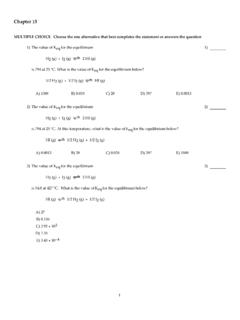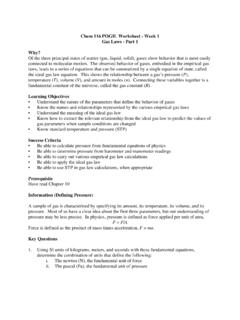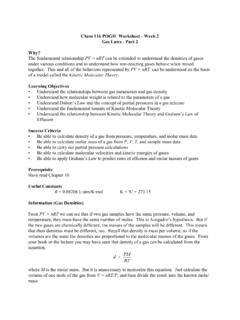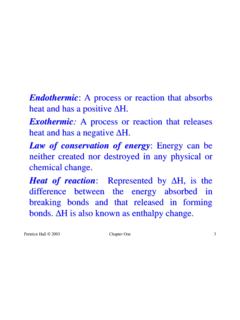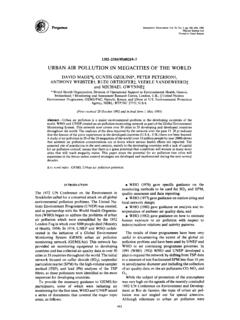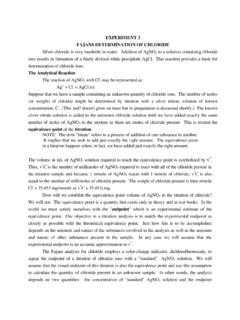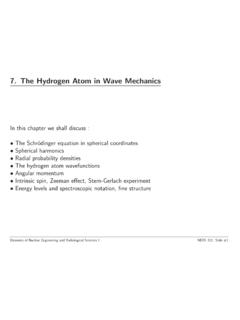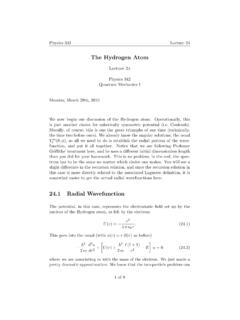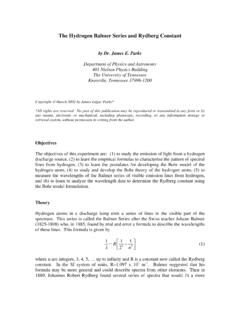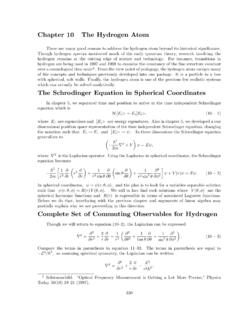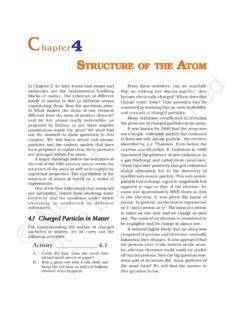Transcription of Derivation of Bohr’s Equations for the One-electron Atom
1 1 FcoulombicFcentrifugal Z+re- Derivation of Bohr s Equations for the One-electron AtomBohr set about to devise a model that would explain the observed line spectra of One-electron atoms, such as H, He+, Li2+. The model Bohr used was based on Rutherford sconclusion from his gold foil experiments that the negative electrons in an atom are a greatdistance away from the positive charge in the nucleus. Bohr began with a classical mechanicalapproach, which assumes that the electron in a One-electron atom is moving in a circular orbitwith a radius, r, from the movement of an electron in its orbit would create a centrifugal force, which gives it atendency to fly away from the nucleus.
2 This force is given byFcentrifugal = -mv2/rwhere m is the mass of the electron, and v is its velocity. In order to have a stable atom, it wasassumed that this centrifugal force was exactly matched by an opposing centripetal force,drawing the electron inward through the coulombic attraction between the electron s negativecharge and the positive charge in the nucleus. This coulombic force of attraction is given byFcoulombic = -Ze2/r2 Equating these two forces, we have(1)mv2r'Ze2r2We can rearrange equation (1), solving for r, to obtain the following expression:(2)r'mv2r2Ze22If we multiply the right side of equation (2) by m/m, this becomes(3)r'm2v2r2mZe2'(mvr)2mZe2 Written in this way, the numerator is the electron s angular momentum squared, (mvr)2.
3 At thispoint, Bohr made an assumption that departs radically from concepts of classical s assumption, called the quantum hypothesis, asserts that the angular momentum, mvr, canonly take on certain values, which are whole-number multiples of h/2 ; ,mvr = nh/2 n = 1, 2, 3, ..where h is Planck s constant. Substituting nh/2 for mvr in equation (3) we obtain the Bohrexpression for the radius:(4)r'n2h24 2mZe2 For the hydrogen atom (Z = 1), the smallest radius, given the symbol ao, is obtained fromequation (4) when n = 1:(5)ao'h24 2me2' is called the Bohr radius.
4 Using the definition of ao in equation (5), we can rewrite equation(4) to obtain a more compact form of the radius equation for any One-electron atom:(6)r'n2aoZSince ao is a constant, equation (6) predicts that the radius increases in direct proportion to thesquare of the quantum number, n2, and decreases in inverse proportion to the atomic number, Z. Thus, the sizes of the orbits in hydrogen are predicted to be ao, 4ao, 9ao, 16ao, 25ao, etc. Furthermore, the orbits in He+ (Z = 2) for any value of n are predicted to be half as large as thecomparable orbits in the radius equation is an interesting result, the more important equationconcerned the energy of the electron, because this correctly predicted the line spectra of One-electron atoms.
5 The Derivation of the energy equation starts with the assumption that theelectron in its orbit has both kinetic and potential energy, E = K + U. The kinetic energy, whicharises from electron motion, is K = mv2. The potential energy, which arises from thecoulombic attraction between the negative charge of the electron and the positive charge in thenucleus, is given by U = Ze2/r. Thus,3(7)E' mv2&Ze2rWe have seen that in Bohr s model the coulombic force is assumed to be equal and opposite tothe centrifugal force [equation (1)]. We can rearrange equation (1) to obtain an expression formv2:(8)mv2'Ze2rSubstituting this into the first term in equation (7) we obtain(9)E'12Ze2r&Ze2r'&12Ze2r'&Ze22rThe negative sign in equation (9) indicates a favorable energy of attraction, which must beovercome to remove the electron to an infinite distance from the nucleus.
6 We can eliminate rfrom equation (9) by substituting equation (4):(10)E'&2 2mZ2e4n2h2If we gather all the constants to define a single constant, B, equation (10) can be written mostsimply as(11)E'&BZ2n2As equation (11) shows, the energy becomes more favorable (negative) in direct proportion tothe square of the nuclear charge, and less favorable (less negative) in inverse proportion to thesquare of the quantum the One-electron atom (H, He+, Li2+, etc.), the lowest energy occurs when n = 1. Thisenergy state is called the ground state.
7 If the atom receives sufficient energy, as in a gasdischarge tube, its electron may jump to a higher orbit (n > 1) with corresponding higher energy. This represents an excited state. The only way the atom can assume a lower-energy state isthrough emission of energy in the form of electromagnetic radiation. The energy of thisradiation is equal to the energy difference between the high state and the lower state:Elight = *Efinal - Einitial* = *Elow - Ehigh*In terms of the Bohr energy equation [equation (11)], the energy of the emitted light should be(12)Elight'*&BZ2n2low&&BZ2n2high*'BZ21 n2low&1n2high4We assume that nhigh is always at least one integer value greater than nlow; nhigh > nlow.
8 Thelower state, nlow, may be either the ground state (n = 1) or any other excited state with a lowervalue of n than the original state, nhigh. Since the energy of electromagnetic radiation isconventionally not given a sense of sign, equation (12) has been formulated here in terms ofabsolute Planck we know that E = h , so if we divide through equation (12) by h we canwrite an expression for the frequencies of the emitted light:(13) 'BZ2h1n2low&1n2highFor hydrogen (Z = 1), the constants outside the brace equal the Rydberg constant in units of hertz(Hz = s-1) ; , BZ2/h = U.
9 This general equation predicts the frequencies of the Balmer series,if the low state is nlow = 2:(14) 'BZ2h1n2low&1n2high'U14&1n2n'3, 4, 5, ..Equation (14) is equivalent to the equation Balmer deduced empirically. It represents thefrequencies for the series of transitions from various excited states to the same lower state forwhich nlow = other values of nlow in equation (13) gives frequencies that predict otherseries of line spectra for hydrogen , which had not been observed at the time Balmer did hisexperiments. Balmer s elucidation of the series for which nlow = 2 was simply a result thatvisible light was the most readily observed kind of electromagnetic radiation with thespectroscopes available in the late nineteenth century.
10 Other series predicted by equation (13)fall either in the ultraviolet or infrared regions, which are more difficult to observeexperimentally. With better instrumentation and the impetus of the Bohr equation, the followingline-spectra were subsequently discovered, in addition to the Balmer series:5nlowRegionSeriesName1ultraviolet Lyman2visibleBalmer3infraredPaschen4infr aredBrackett5infraredPfundThe ability to predict the frequencies of these series gave credibility to the Bohr model. However, all attempts to extend this approach to multi-electron atoms failed.

